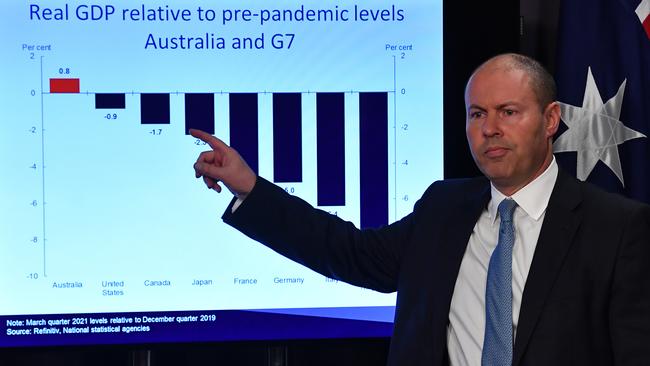
But there’s a cloud. Lockdowns are instantly brutal and leave a long tail of economic woe. After last year’s four-month torture, Victoria’s economy bounded along in the December and March quarters to lead all states with cumulative growth in final demand of 9.6 per cent.
And yet, that still wasn’t enough to drag Victoria’s output back above its pre-Covid-19 level. The lockdown’s extension for Melbourne brings more pain.
“The biggest risk to the outlook comes from the pandemic itself, as Victoria’s lockdown shows,” ANZ Bank senior economist Felicity Emmett said of an economy “back in the black”.
“While the last year has shown confidence and spending tend to bounce back quickly after short lockdowns, the current lockdown may have a larger impact given the absence of JobKeeper.”
GDP may be higher than its pre-pandemic level but spending on services, where most people work, remains 2.6 per cent below where it was a year earlier.
There was a rebound in summer for eating out, recreation and travel, but spending on services was coming out of the deep end. In the year to last June, services spending plunged by 20 per cent.
Hospitality, transport and arts and recreation are three of seven industries where output is below pre-crisis levels. Transport services have recovered but are about 75 per cent below the previous high, reflecting structural change and state restrictions.
In an article accompanying the national accounts, the ABS said there was a strong correlation between GDP growth and change in visits to retail and recreational locations measured by Google mobility data. Countries that have experienced lower levels of mobility have generally reported weaker output results, such as Spain and Italy, with GDP one-third below pre-crisis levels.
Along with Sweden, we are at the opposite end, with about half the fall in mobility of those nations “reflecting faster easing of Covid-19 restrictions relative to most OECD countries”.
Our GDP is 0.8 per cent higher than at December 2019 while Sweden’s is 1.1 per cent lower.
Containment measures here were strictest in the June quarter, and consumer spending slumped by 12 per cent. “Mobility increased in subsequent quarters as low case numbers in most states and territories allowed Covid-19 restrictions to ease at a faster rate than most OECD countries. This resulted in increased household spending and quicker economic recovery,” the ABS noted.
Now reality bites, and the long tail of lockdowns. While household spending has made a good recovery in Victoria, business investment is lagging. “Businesses may still be wary about investment following the long period of lockdowns last year. In that context, the latest restrictions in Melbourne are a setback,” say CBA senior economists Kristina Clifton and Belinda Allen.
As long as the lockdown is short and sharp, the expansion can continue apace. But border closures and near zero population growth will keep a lid on the economy’s trajectory.
Let’s not riff here on weak productivity growth. For a full concerto, look no further than Wednesday’s ripping speech by former reform policy tsar Gary Banks. Productivity remains a dirty word in our politics, so we persist with sugar hits and misses, living off spectacular pay rises the world keeps showering us with for mineral ore extraction.




Australia is moving from recovery to expansion mode, three full-bodied quarters after touching the void last June. Government money is slowly being withdrawn and consumers and companies are spending up big on houses, dining out, tools and utes.